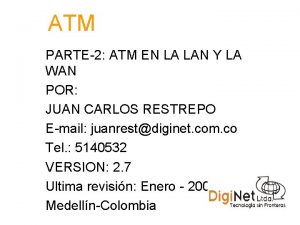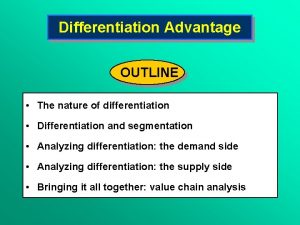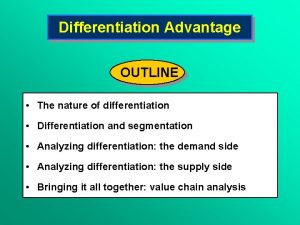20162017 LEC 5 APPLICATION OF DIFFERENTIATION 1 2






- Slides: 6

2016/2017 LEC. 5 : APPLICATION OF DIFFERENTIATION 1. 2 Application of Differentiation Theorem: 1. if 2. if on (a, b) then f is increase on (a, b) then f is decrease on (a, b). Ex: On which intervals is the function f(x) = x 3 -3 x 2 +1 increase , decrease. ( x) =3 x 2 – 6 x =3 x ( x – 2 ) =0 either x=0 or x=2 +++++ ------ +++++++ sign of ( x) 0 2 So f(x) is increase on and decrease on (0, 2) Def. : a function f(x) is concave up on (a, b) if f (x) 0 and concave down on (a, b) if f (x) 0 Ex: find the intervals where the fun. f(x) = x 3 -3 x 2 +1 concave up, concave down ( x) =3 x 2 -6 x f (x) = 6 x- 6=6(x-1)=0 equal to zero at x=1 ------- ++++ sign of f (x) 1 f concave up on and concave down on Def. : Let f be a continuous function on [a, b] and f changes direction of concavity at xo then (xo , f(xo)) called an inflection point of f. or (xo , f(xo)) is an inflection point of f if f (x) =0 Ex: Find the location of all inflection points of f(x) = x 4 - 8 x 2 +16 ( x) =4 x 3 -16 x 1

2016/2017 LEC. 5 : APPLICATION OF DIFFERENTIATION f (x) =12 x 2 – 16=4(3 x 2 – 4)=0 x= √ ( ( ) inflection points √ √ Ex: Find the intervals in which the function ⁄ Is increasing , decreasing , concave up , concave down , and inflection point. ⁄ ⁄( ) ⁄ ⁄ ⁄ = ⁄ ⁄ --------- +++++++++ -1 0 f increase on (-1, 0) , f decrease on ⁄ sign of f (x) = ( ⁄ ) ⁄ = ⁄ ++++++ ------- +++++++ sign of f (x) 0 2 f concave up on , concave down on (0, 2) (2 , 7. 6) is the inflection point 1. 3 Sketching Graphs of polynomials and Rational functions Ex: Sketch the graph of the curve x=1 x= -1 2

2016/2017 LEC. 5 : APPLICATION OF DIFFERENTIATION +++++ -------- +++++++ 1 -1 sign of f increase on f decrease on (-1, 1) is relative maximum f (-1) = 4 is relative minimum f (1) = 0 f (x) = 6 x= 0 is inflection point ------- +++++ sign of f (x) 0 f is concave up on and concave down on y axis 5 4 3 2 1 1 2 3 x axis 1 2 Ex: sketch the graph of (x-1)(x+1) = 0 are vertical asymptote. y =1 is Horizontal asymptote ++++ ---------- sign of 1 -1 0 f increase on f decrease on (0, 1) , 3

2016/2017 LEC. 5 : APPLICATION OF DIFFERENTIATION f (x) +++++ ------ ++++++ sign of f (x) -1 1 f is concave up on and concave down on y axis 4 3 2 1 Y=1 1 2 3 x axis 1 2 3 x=-1 x=1 Ex: Sketch the graph of the rational function is the vertical asymptote There is no Horizontal asymptote x x 2 x 3 4 y= -x is the oblique asymptote �x 3 4 ------ +++++++ -2 sign of 0 ------- f decrease on f increase on (-2, 0) (-2 , 3) is relative minimum 4

2016/2017 LEC. 5 : APPLICATION OF DIFFERENTIATION y axis 10 8 6 4 2 2 4 x axis 2 4 f (x) ( Y=-x ) There is no inflection point +++++++++++ sign of f (x) 0 f is concave up on 1. 4 Newton method: used to find the roots of the function f(x) Numerically. Ex: use newton method to approximate the solution of X -2 f(x) - -1 - 0 - 1 - 2 + 3 + f(1)=-1 and f(2)=5 the sign is vary for the function between x=1 and x=2 so the root lie between them , choose let 5

2016/2017 LEC. 5 : APPLICATION OF DIFFERENTIATION No need to continue because we reached the accuracy so 6











